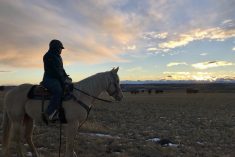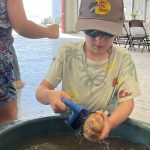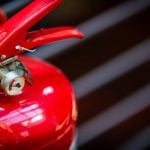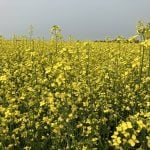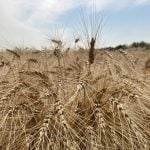Like many farm operations Kirlene Cattle takes its name from the owners. Kirby and Arlene Hakkesteegt raise purebred Charolais cattle between Brighton and Trenton just north of Lake Ontario in Ontario’s Northumberland County. They have four grown children and farm with their 23-year-old son Bryce. Another son, Kevin is planning to return to the farm soon. The cattle business is combined with a broiler operation on 160 hectares of land in a part of the province well known for its many apple orchards.
While the cattle business is a secondary enterprise to the chicken operation, they have over the years developed some simple devices and methods to make calving time more productive and efficient. The cows calve in January and February at the home farm in a shed about 16 metres square with one wall open to the south. It is well designed and equipped with good handling equipment.
Read Also

Reintroducing fire to Saskatchewan pastures
Pastures evolve over time. Woody plants and shrubs, which cattle can’t eat, may encroach on natural grasses. Invasive species, such…
“The chickens allow us to have some better equipment,” says Kirby, “but we still have to make money.”
Kirby and his son Bryce are slender and tall, both well over six feet. Arlene is petite and lively. Friendly and forthright, Kirby speaks with a clipped precision that suggests he is a person who likes to have things organized. The farmstead reflects this attitude. It is clean and uncluttered.
“It’s almost a full-time job keeping things tidied up,” says Kirby. “My father started this farm in 1975. At first we were in the egg business and then switched over to meat chickens. My wife grew up on a dairy farm and when we got married that’s where part of the interest in cattle came from. We started with a herd of commercial cows in 1984 and beginning in the mid-’90s we started to switch over to the purebred Charolais. We started the purebred herd with a registered cow-calf pair. We planned to keep heifers and gradually replaced the commercial cows so we’ve bred and raised most of our females. We do buy a few to incorporate different traits. Because we were building a cow herd, starting out there was an emphasis on milk and calving ease.”
For purebred breeders there are marketing advantages to winter calving but it can be a challenge. While the climate near Lake Ontario is moderate compared to some other parts of Canada it can get cold and raw in January and February. To lose a calf is a big financial hit. Kirby likes to be prepared and is always looking for ways to improve his facilities and approach. It appears to be a trait that is genetic.
“A lot of the special little facilities we use at calving time and around the farm were made by my father,” says Kirby. “He’s retired now but has been a big help with the cattle operation.”
Outside the calving shed there are three large pens for holding cattle as they come up to calve and to keep cows and older calves. Inside the open wall of the barn there are two large pens divided by a feed bunk equipped with locking head gates.
“The locking head gates are important for us because we breed about 70 per cent of the cows and heifers artificially,” says Kirby. “We use heat synchronization because it allows us to split straws of expensive semen and breed 10 cows with five doses. We also pregnancy check everything and because we handle the cattle so much the facilities save time and money. At calving time we still watch for the traditional physical signs like a cow bagging up but it’s a huge advantage to have good information about the cows’ due dates.”
As the cows approach their calving date they are first brought into one of the two large pens inside the calving shed created by the feed bunk. Across an alleyway along the back wall of the barn there is a long pen that can be divided into four smaller pens by gates. This is where the cows calve. In one corner of the calving pen there is an opening in the gate panel large enough for a newborn calf to get through. It leads to a small wooden structure about a metre square that Kirby calls a “hot box.”
“My father made it,” explains Kirby. “It’s just a box open on one side built out of plywood with a heat lamp mounted in the top and a sheet of Styrofoam insulation on the floor. We put the calf in it as soon as the cow has licked it off. The cow can still reach the calf because of the size of the opening. If it’s cold, say 15 or 20 below zero, you can see steam coming off the calf. It’s the calf’s coat drying off.”
From the calving pens the cows and newborns are moved into the larger pen on the other side of the feed bunk. In the middle of the wall across from the bunk there is a strip of plastic mounted vertically. It looks like a piece of PVC pipe a little less than a metre long. Running the length of the plastic strip there is a row of metal eyelets to hold the spring-loaded handle of an electric fence wire. There is also an insulated terminal on the feed bunk and by running a wire from the feeder across to the clips on the wall Kirby makes a large area for the calves to lie down that is clean and dry. Because of the vertical sequence of terminals he can adjust the electric wire up and down.
“It’s another thing my father made,” explains Kirby. “Because the barn is open to the south the sunlight streams in and makes it warm. We bed up the back half of the pen with straw and keep the cows out with the electric wire. Because we can adjust the height up and down we can match the opening to the size of the calves. We can also raise it as the manure pack builds up through the calving season. To encourage the calves to use the creep we purposely keep the bottom end of the pen a bit sloppy.”
Outside the barn there is another larger pen that is used as a creep when the calves get older. Inside the pen there is a covered feeder where the calves can be fed grain. The entrance is homemade out of two-by-fours and plywood. A plywood panel slides back and forth across the opening and is pinned to set the size.
“My father made it,” says Kirby with a grin.
Despite the extra effort Kirby is committed to winter calving.
“We might occasionally get a frostbitten ear but we really don’t have many problems,” says Kirby. “To be honest I wouldn’t do it any other way.”







